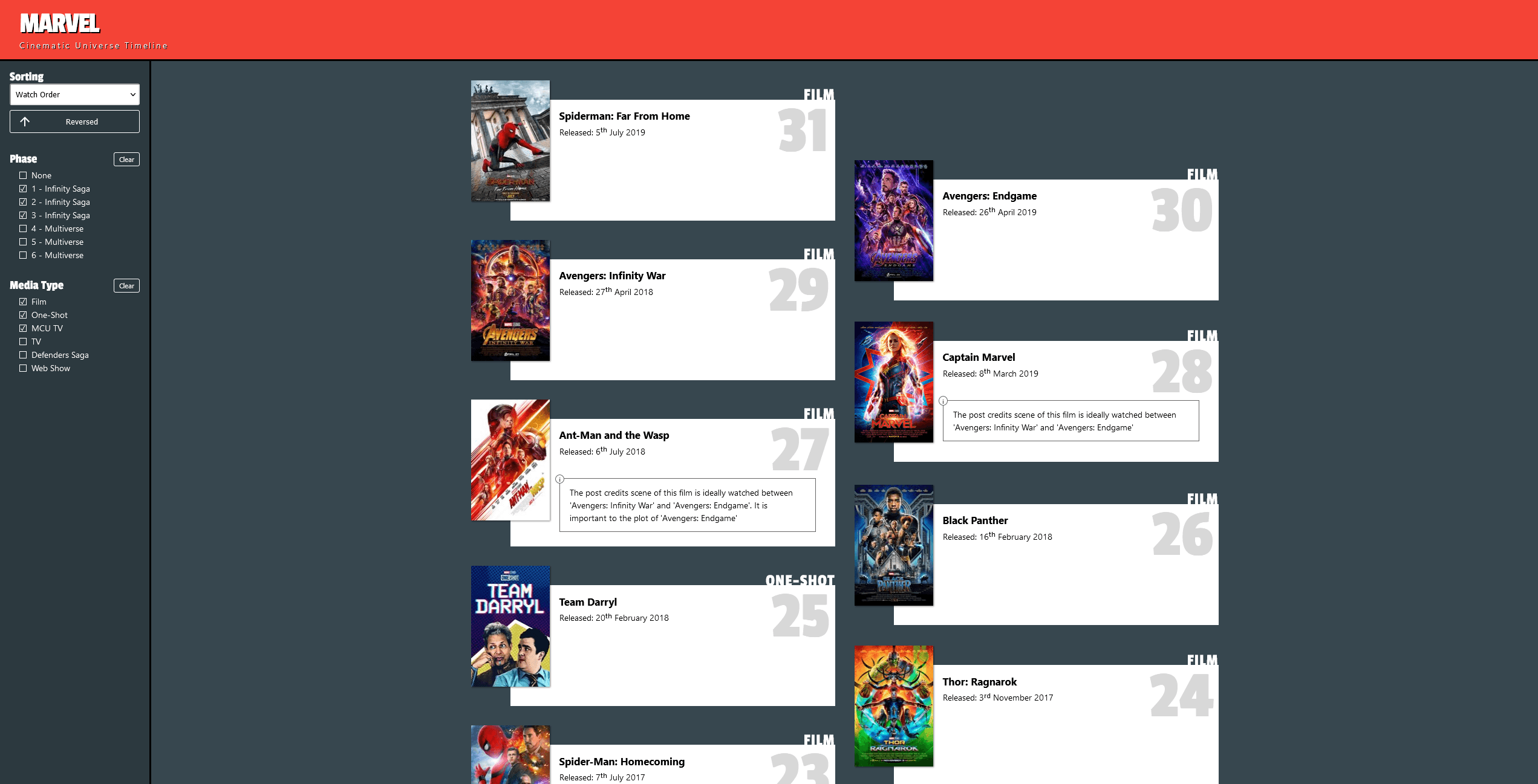MCU Timeline
Like most developers, at one point I made a quick tool in a weekend for one simple idea, and spawned myself half a decade of tech support.
In the long long ago of 2016, Marvel had just started the fourth season of their spin off TV show Agents of S.H.I.E.L.D. and were full steam releasing Netflix shows. The Marvel Cinematic Universe was spinning out beyond the mainline movies and becoming harder to keep track of, so I created a list for myself where I worked out which order I should be watching these episodes in to make the most sense interweaved with the movies.
Wouldn't it be great if someone was maintaining such a list online that I could reference? Wait, I'm a someone!

Go give it a look here: https://mcu-timeline.com/ and check out the full source code on GitHub.

In the beginning
The first build of this site consisted of taking my ordered list, converting it into JSON and I wrote a javascript loop to convert that list into HTML at build time.
Realising any interactivity I wanted to add would require a client side re-render, I bundled my JSON and the render loop into a script and added it to the page. The first interactivity I added was a toggle to use the exact release date order, or my opinionated ordering.
[
{
"type": "Film",
"name": "Iron Man",
"releaseDate": [2008, 4, 2],
"watchOrder": 10
},
{
"type": "Film",
"name": "The Incredible Hulk",
"releaseDate": [2008, 5, 13],
"watchOrder": 20
},
{
"type": "Short Film",
"name": "The Consultant",
"releaseDate": [2011, 8, 13],
"watchOrder": 30
}
}To this day my base data is essentially this same structure, but with a few extra properties added for new features, and some type safety.
The first version of my build scripts were using Gulp to run tasks, which mostly consisted of concatenating all of my script files and running it through Babel to transpile for ES5. With some linting, minify any images, and I was using SASS to build my stylesheets.
New features
Over time I have been adding in new features. Nothing too notable, some additional filters and more sorting options. Spent way too long getting TV shows to split into multiple sections and wrap around films automatically.
A year in and I dropped the jQuery dependency, moving all of my render logic into vanilla JS. I also added Webpack into the build to make actual use of ESM, as nice as concatenating files was.
I gave the UI a couple of makeovers over time, notably I added in movie posters, so I could make the maintenance that little bit harder having to find a poster for every show.
Rebuild
There came a point where I had outgrown the original setup for this project. I had learnt new technologies, and better ways of working over time that I wanted to implement here.
I went back to the start and rebuilt the entire stack for the site. Did I add React? No we only build jank around here, and I wanted to stick with vanilla to remain light on the shipped dependencies.
What I did add was Typescript and PostCSS into my build tooling, dropping SASS. ESLint and Prettier for keeping the code nice and tidy. Babel was gone, along with Gulp, moving my build scripting into npm scripts. Webpack made it though as the lone survivor.
"scripts": {
"build": "npm-run-all clean -p build:js build:css build:img build:public build:html",
"start": "npm-run-all build -p watch:* start:server",
"start:server": "browser-sync dist -w",
"watch:js": "nodemon --watch src -e js,ts,json -x \"npm run build:js\"",
"watch:css": "nodemon --watch src -e css,scss -x \"npm run build:css\"",
"watch:img": "nodemon --watch src/img -x \"npm run build:img\"",
"watch:public": "nodemon --watch src/public -x \"npm run build:public\"",
"watch:html": "nodemon --watch src -e html -x \"npm run build:html\"",
"clean": "rimraf dist",
"build:js": "node ./scripts/webpack.mjs",
"build:css": "postcss src/css/index.scss --no-map -o dist/style.css",
"build:img": "node ./scripts/images.mjs",
"build:public": "node ./scripts/public.mjs",
"build:html": "npm-run-all html:clean html:js html:render html:minify html:clean",
"html:clean": "rimraf .temp",
"html:js": "tsc --outDir .temp/ --target esnext --allowSyntheticDefaultImports --esModuleInterop",
"html:render": "node ./scripts/render.js",
"html:minify": "html-minifier --input-dir dist --output-dir dist --file-ext html --remove-comments --collapse-whitespace"
},Shortly after I did revive Babel as part of the Webpack build as I was using a handful of modern JS features that had fairly shallow backward compatibility.
Will I switch to React at some point? Yea that probably makes some sense as the render logic continues to grow, but for now string formatting is getting me by.
render(index: number, additionalHtml?: string, released?: boolean): string {
released = released ?? this.released;
return `<li>
<div class="timeline-card timeline-card_${this.type} ${!released ? "is-unreleased" : ""}">
<div class="timeline-posterFrame">
<img class="timeline-poster" src="${this.imgUrl}" alt="Poster for ${this.name}"/>
</div>
<div class="timeline-detail">
<div class="timeline-vol"> ${index} </div>
<div class="timeline-type"> ${formatShowType(this.type)} </div>
<h2 class="timeline-title"> ${this.name} </h2>
${this.renderAdditionalHeadings()}
${this.notes ? `<div class="timeline-notes">${markdown(this.notes)}</div>` : ``}
${additionalHtml ?? ""}
</div>
</div>
</li>`;
}